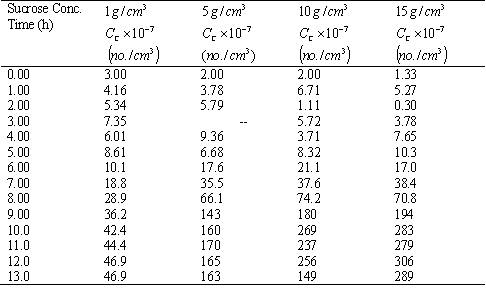(a) From the data below, determine the lag time, the time to reach the stationary phase, the Michaelis constant, KS, and the reaction velocity,
(b) Will an inhibition model of of the form
An understanding of bacteria transport in porous media is vital to the
efficient operation of the water flooding of petroleum reservoirs. Bacteria can
have both beneficial and harmful effects on the reservoir. In enhanced microbial
oil recovery, EMOR, bacteria are injected to secrete surfactants to reduce the
interfacial tension at the oil-water interface so that oil will flow out more
easily. However, under some circumstances the bacteria can be harmful, by
plugging the pore space and thereby block the flow of water and oil. One
bacteria that has been studied, Leuconostoc mesenteroides, has the
unusual behavior that when it is injected into a porous medium and fed sucrose,
it greatly reduces the flow (i.e., damages the formation and reduces
permeability). When the bacteria are fed fructose or glucose, there is no damage
to the porous medium. [R. Lappan and H.S. Fogler, SPE Prod. Eng., 7(2),
167-171 (1992)]. The cell concentration, CC, is given below as a
function of time for different initial sucrose concentrations.
(a)
From the data below, determine the lag time, the time to reach the
stationary phase, the Michaelis constant, KS, and the reaction
velocity,![]() , as a function
of sucrose concentration.
, as a function
of sucrose concentration.
(b) Will an inhibition model of of the
form

where n and ![]() are
parameters, fit your data?
are
parameters, fit your data?
Cell Concentration Data